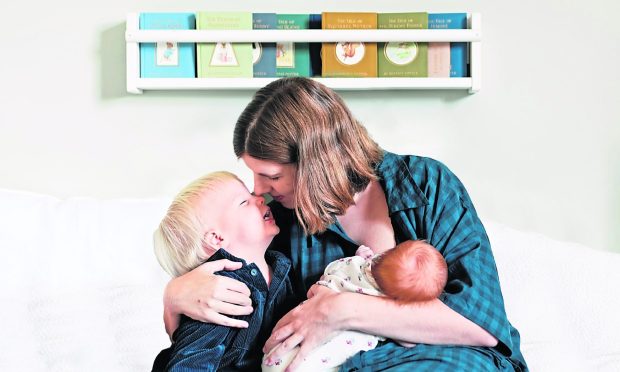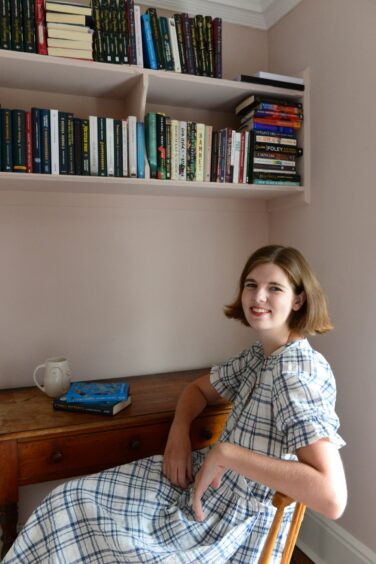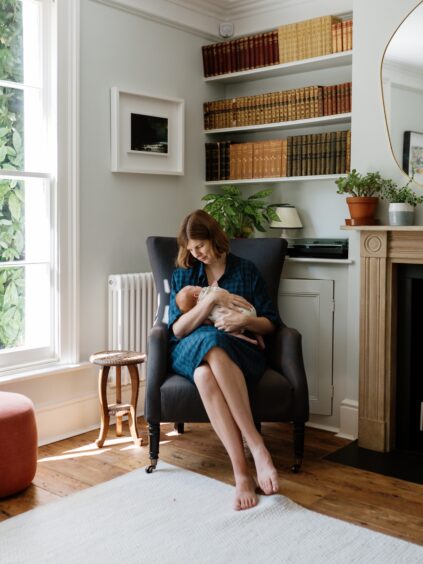
Growing up in Edinburgh, Elizabeth Macneal admits she could never have imagined a day when, six weeks pregnant and with a toddler on her hip, she would have a cameo role in a TV drama she created, or that she would go on to develop potentially deadly sepsis and survive.
The six-part screen series The Doll Factory – based on 35-year-old Elizabeth’s titular debut novel – changed her life. The book ignited a 14-way bidding war, landed a six-figure advance and deals in 29 countries before sparking a fight for TV rights. Finally broadcast last winter on Paramount and Channel 5 – starring Esme Creed-Miles as aspiring artist Iris Whittle and Mirren Mack as her resentful seamstress twin, Rose – it was brought to the screen by Buccaneer Media.
Elizabeth, also the author of Circus of Wonders, this week launched her third novel, The Burial Plot, a riveting and macabre gothic thriller set in Victorian London featuring a young woman wresting power from a dangerous man.
Speaking to P.S. from the riverside London home she shares with her family, husband Jonny and their little ones Arthur, almost three, and Esme, 10 months – to whom the book is dedicated – the author beams: “It was incredible to launch The Doll Factory on TV last November, and a big highlight to be part of it. Arthur was 18 months when it was filmed, and I was six weeks pregnant with Esme. I hadn’t told anyone I was pregnant. They put me in a corset, and as it was being pulled tighter and tighter, I was thinking, ‘oh my gosh is this in my daughter’s interests’, but she seems to be all right, although she might be claustrophobic when she’s older,” she jokes.
“Arthur and I had 0.5 seconds of screen time, a very important 0.5 seconds, but he nearly got fired,” she laughs. “We were initially in a big scene, and he was behaving immaculately, but then lead character Iris walked onto set with a basket of apples and stood right in front of him. My son likes his food, and he began shouting, ‘apple, apple, apple!’
“It was amazing to turn up on set and see these scenes that had previously existed in my mind become tangible and real. To be able to pick up the little oyster shell that contained paints for Iris’s brushes was incredible. These things were mind blowing.”
Becoming a mother
But not nearly as mind blowing, she says, as twice becoming a mother, juggling the demands of her new role with writing and, after a frightening brush with sepsis, facing the possibility of her children growing up without her.
“I started writing The Burial Plot when Arthur was months old and finished writing it the day Esme was born. I contracted sepsis from mastitis when she was four weeks old and was in hospital for a week. I needed intravenous antibiotics. My mum flew down from Edinburgh. I couldn’t even hold Esme to feed her, and you must keep feeding through the mastitis.
“It was scary. Sepsis is a life-threatening illness, and I had just had a baby. There were a couple of dark moments when you do imagine your children growing up apart from you. But those were small moments.
“Most of all, I felt incredible gratitude to be born in the century I have been born in. If I’d inhabited my book, I would have died. The Victorian era wasn’t all it was cracked up to be when it came to medicine, especially maternal medicine.”
Scary too, she admits, was the prospect of maintaining a burgeoning and successful writing career with motherhood.
Elizabeth – who had already made the leap from a career in management consultancy to become a potter and fully-fledged author – reveals: “It should not be underestimated the impact that having children can, and does, have on writing. Before I had Arthur, I fixated slightly on English literary critic Cyril Connolly’s ‘pram in the hall’.” Connolly is famously quoted as saying ‘There is no more sombre enemy of good art than the pram in the hall’.”
Elizabeth – who went to Edinburgh’s St Joseph’s primary school before earning a coveted scholarship to the city’s exclusive Fettes College, later studying English at Oxford University – says: “I now detest that image because it seemed like an obstruction, something that was going to come between me and the writing which I loved. But what I began to realise, and what surprised me, was just how much I wanted my approach to writing to change, I wanted it to be a different practice.
“I hadn’t considered that Arthur could fit into my writing quite happily and that my writing would adapt to fit around him.”
Combining motherhood and writing
The transition was made possible by the arrival of a nanny and a landmark first birthday for Arthur. “People would ask me if I’d write during Arthur’s naps, and I know of other writers who do that. But I wouldn’t expect my husband to manage his career during our child’s naps, or my brother, who is a plastic surgeon, to carry out surgery during his child’s naps.
“There is something about being creative and being a woman, where you find yourself and your work being forced into smaller and smaller spaces, and I have tried, as much as I can, to protect that space.
“The happiest way to combine both motherhood and writing was to take each of them seriously and to give each of them dedicated time.
“I got a nanny quite early on but it took me about a year to find my groove, and my way into the story. I had the pram in the hallway going through my head. And then Arthur turned one. It really changed me.
“Previously my approach to writing had been one of almost monastic obsession. I’d go straight from getting up in the morning to my desk, I wouldn’t even have breakfast, and that is not an option when you have children. But I have learned to think about my writing differently. It hasn’t consumed me obsessively, and has played along quite contentedly.
“My work now is more sustainable with relationships. It is an approach of greater balance and can therefore produce better writing. When I am most contented and most happy, my writing flows.”
🥳🎉Wishing wondrous @esmacneal the happiest of publication days. #TheBurialPlot is an engrossing, intricately plotted, superbly paced work of historical fiction peopled by nuanced characters in intensely evocative settings. If you’re a fan of Victorian Gothic, this is a must 🖤 pic.twitter.com/8dcep1xzqT
— Camilla Elworthy (@CamillaElworthy) June 6, 2024
Elizabeth is in Scotland for a series of book launch events this month. She is at the Borders Book Festival on June 16, followed by events in East Linton, Edinburgh, St Andrews, and Dundee between June 17 and 20.
Little Arthur – named after her cherished late grandfather – is thrilled. His mum smiles: “He is obsessed with Scotland, we’re there all the time. Every single day Arthur wakes up and begs me to go to Scotland.
“We come up to my mum at least every two months, she is the most doting, incredible grandparent. She often looks after the kids and takes them to playgroup so that I can get on with my writing and makes it as easy as possible.
“It is like the relationship I had with my grandpa Arthur, and my grandma Enid. I see that playing out with my kids and their grandma and gramps.”
The Burial Plot by Elizabeth Macneal (Picador), is out now. elizabethmacneal.com/events

Enjoy the convenience of having The Sunday Post delivered as a digital ePaper straight to your smartphone, tablet or computer.
Subscribe for only £5.49 a month and enjoy all the benefits of the printed paper as a digital replica.
Subscribe © Supplied
© Supplied © Supplied
© Supplied